Financial Accounting and Reporting: Principles and Applications
VerifiedAdded on 2020/10/05
|26
|4568
|177
Report
AI Summary
This report provides a comprehensive overview of financial accounting, beginning with a definition and exploring relevant regulations. It delves into accounting rules and principles applicable within an organization, including debit/credit rules, going concern, matching, and revenue recognition principles. The report then examines conventions and concepts such as material disclosure and consistency. Part B applies these principles through several client case studies, including double-entry recording, trial balance preparation, and financial statement analysis (profit and loss, balance sheet). It covers adjustments, depreciation, and bank reconciliation, alongside ledger control accounts and suspense account reconciliation. The report concludes with an understanding of different account types and a brief conclusion. The report offers a detailed analysis of financial accounting concepts and their practical applications through diverse case studies.
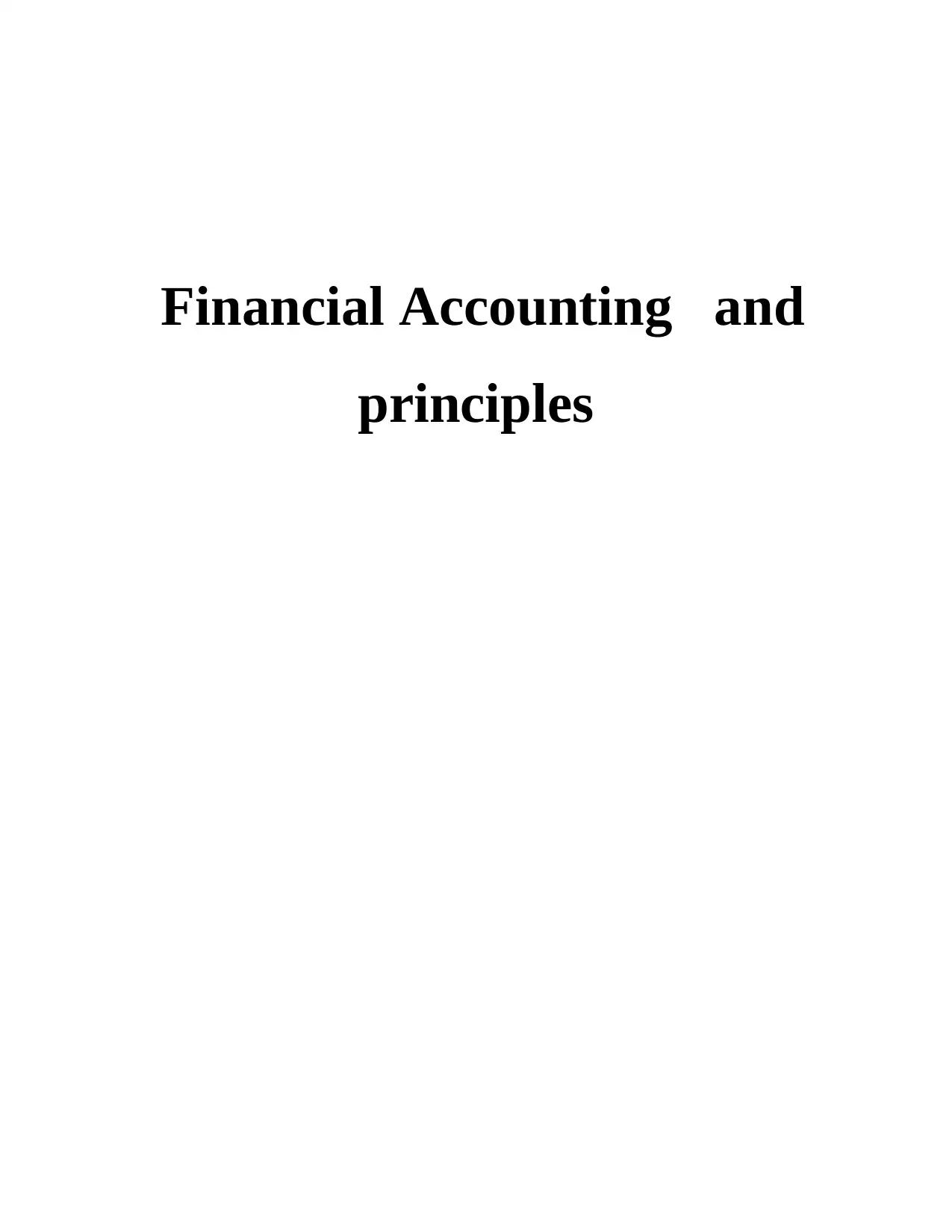
Financial Accounting and
principles
principles
Paraphrase This Document
Need a fresh take? Get an instant paraphrase of this document with our AI Paraphraser
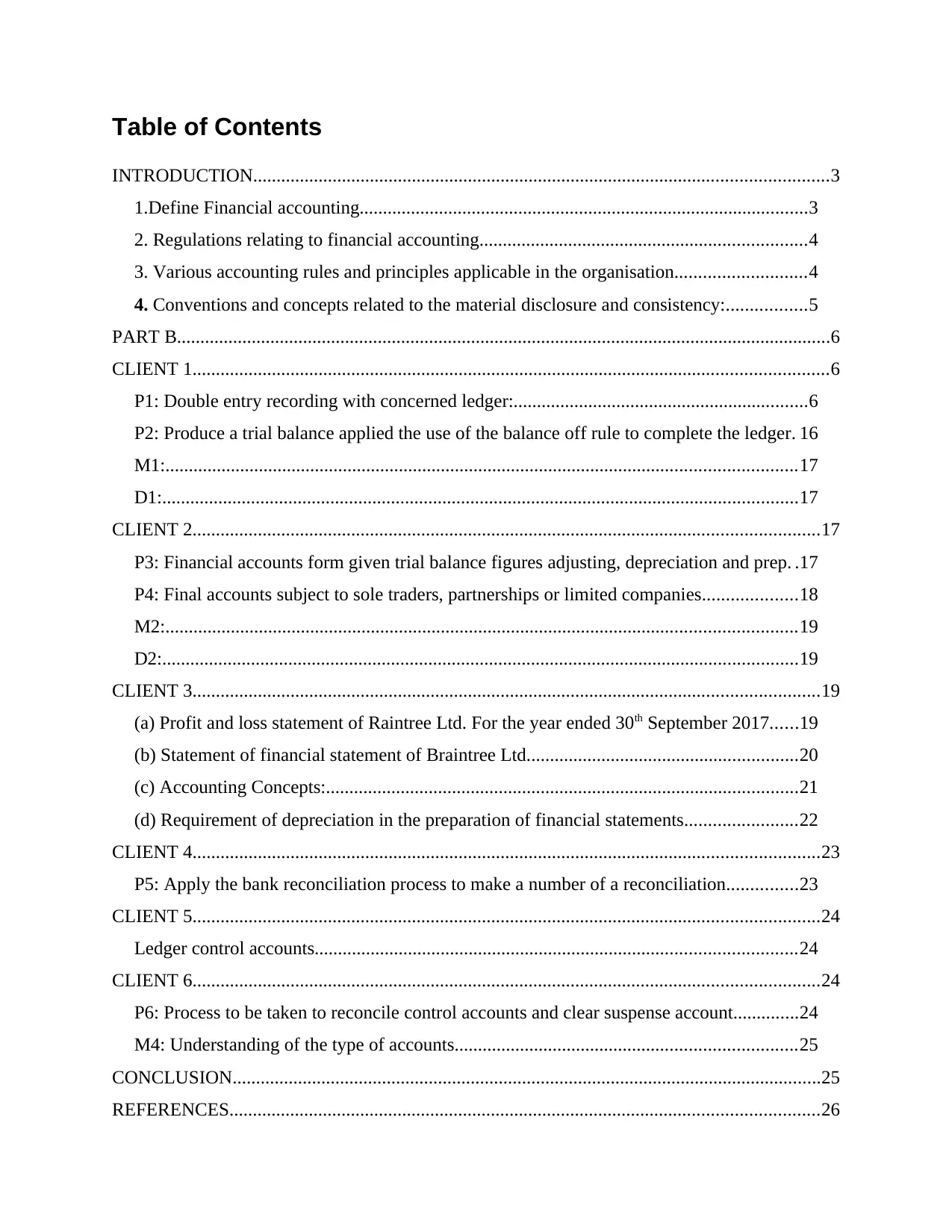
Table of Contents
INTRODUCTION...........................................................................................................................3
1.Define Financial accounting................................................................................................3
2. Regulations relating to financial accounting......................................................................4
3. Various accounting rules and principles applicable in the organisation............................4
4. Conventions and concepts related to the material disclosure and consistency:.................5
PART B............................................................................................................................................6
CLIENT 1........................................................................................................................................6
P1: Double entry recording with concerned ledger:...............................................................6
P2: Produce a trial balance applied the use of the balance off rule to complete the ledger. 16
M1:.......................................................................................................................................17
D1:........................................................................................................................................17
CLIENT 2......................................................................................................................................17
P3: Financial accounts form given trial balance figures adjusting, depreciation and prep. .17
P4: Final accounts subject to sole traders, partnerships or limited companies....................18
M2:.......................................................................................................................................19
D2:........................................................................................................................................19
CLIENT 3......................................................................................................................................19
(a) Profit and loss statement of Raintree Ltd. For the year ended 30th September 2017......19
(b) Statement of financial statement of Braintree Ltd..........................................................20
(c) Accounting Concepts:.....................................................................................................21
(d) Requirement of depreciation in the preparation of financial statements........................22
CLIENT 4......................................................................................................................................23
P5: Apply the bank reconciliation process to make a number of a reconciliation...............23
CLIENT 5......................................................................................................................................24
Ledger control accounts.......................................................................................................24
CLIENT 6......................................................................................................................................24
P6: Process to be taken to reconcile control accounts and clear suspense account..............24
M4: Understanding of the type of accounts.........................................................................25
CONCLUSION..............................................................................................................................25
REFERENCES..............................................................................................................................26
INTRODUCTION...........................................................................................................................3
1.Define Financial accounting................................................................................................3
2. Regulations relating to financial accounting......................................................................4
3. Various accounting rules and principles applicable in the organisation............................4
4. Conventions and concepts related to the material disclosure and consistency:.................5
PART B............................................................................................................................................6
CLIENT 1........................................................................................................................................6
P1: Double entry recording with concerned ledger:...............................................................6
P2: Produce a trial balance applied the use of the balance off rule to complete the ledger. 16
M1:.......................................................................................................................................17
D1:........................................................................................................................................17
CLIENT 2......................................................................................................................................17
P3: Financial accounts form given trial balance figures adjusting, depreciation and prep. .17
P4: Final accounts subject to sole traders, partnerships or limited companies....................18
M2:.......................................................................................................................................19
D2:........................................................................................................................................19
CLIENT 3......................................................................................................................................19
(a) Profit and loss statement of Raintree Ltd. For the year ended 30th September 2017......19
(b) Statement of financial statement of Braintree Ltd..........................................................20
(c) Accounting Concepts:.....................................................................................................21
(d) Requirement of depreciation in the preparation of financial statements........................22
CLIENT 4......................................................................................................................................23
P5: Apply the bank reconciliation process to make a number of a reconciliation...............23
CLIENT 5......................................................................................................................................24
Ledger control accounts.......................................................................................................24
CLIENT 6......................................................................................................................................24
P6: Process to be taken to reconcile control accounts and clear suspense account..............24
M4: Understanding of the type of accounts.........................................................................25
CONCLUSION..............................................................................................................................25
REFERENCES..............................................................................................................................26
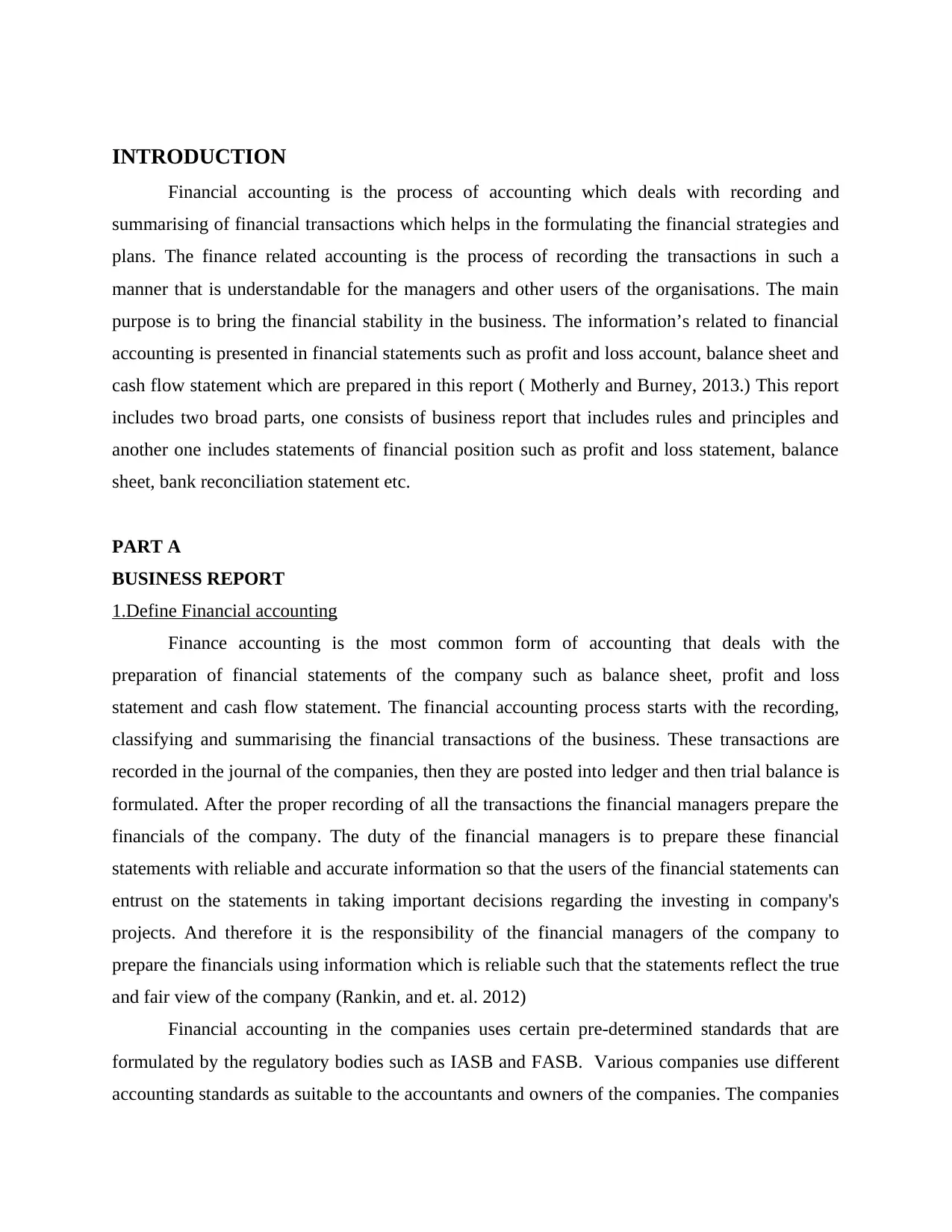
INTRODUCTION
Financial accounting is the process of accounting which deals with recording and
summarising of financial transactions which helps in the formulating the financial strategies and
plans. The finance related accounting is the process of recording the transactions in such a
manner that is understandable for the managers and other users of the organisations. The main
purpose is to bring the financial stability in the business. The information’s related to financial
accounting is presented in financial statements such as profit and loss account, balance sheet and
cash flow statement which are prepared in this report ( Motherly and Burney, 2013.) This report
includes two broad parts, one consists of business report that includes rules and principles and
another one includes statements of financial position such as profit and loss statement, balance
sheet, bank reconciliation statement etc.
PART A
BUSINESS REPORT
1.Define Financial accounting
Finance accounting is the most common form of accounting that deals with the
preparation of financial statements of the company such as balance sheet, profit and loss
statement and cash flow statement. The financial accounting process starts with the recording,
classifying and summarising the financial transactions of the business. These transactions are
recorded in the journal of the companies, then they are posted into ledger and then trial balance is
formulated. After the proper recording of all the transactions the financial managers prepare the
financials of the company. The duty of the financial managers is to prepare these financial
statements with reliable and accurate information so that the users of the financial statements can
entrust on the statements in taking important decisions regarding the investing in company's
projects. And therefore it is the responsibility of the financial managers of the company to
prepare the financials using information which is reliable such that the statements reflect the true
and fair view of the company (Rankin, and et. al. 2012)
Financial accounting in the companies uses certain pre-determined standards that are
formulated by the regulatory bodies such as IASB and FASB. Various companies use different
accounting standards as suitable to the accountants and owners of the companies. The companies
Financial accounting is the process of accounting which deals with recording and
summarising of financial transactions which helps in the formulating the financial strategies and
plans. The finance related accounting is the process of recording the transactions in such a
manner that is understandable for the managers and other users of the organisations. The main
purpose is to bring the financial stability in the business. The information’s related to financial
accounting is presented in financial statements such as profit and loss account, balance sheet and
cash flow statement which are prepared in this report ( Motherly and Burney, 2013.) This report
includes two broad parts, one consists of business report that includes rules and principles and
another one includes statements of financial position such as profit and loss statement, balance
sheet, bank reconciliation statement etc.
PART A
BUSINESS REPORT
1.Define Financial accounting
Finance accounting is the most common form of accounting that deals with the
preparation of financial statements of the company such as balance sheet, profit and loss
statement and cash flow statement. The financial accounting process starts with the recording,
classifying and summarising the financial transactions of the business. These transactions are
recorded in the journal of the companies, then they are posted into ledger and then trial balance is
formulated. After the proper recording of all the transactions the financial managers prepare the
financials of the company. The duty of the financial managers is to prepare these financial
statements with reliable and accurate information so that the users of the financial statements can
entrust on the statements in taking important decisions regarding the investing in company's
projects. And therefore it is the responsibility of the financial managers of the company to
prepare the financials using information which is reliable such that the statements reflect the true
and fair view of the company (Rankin, and et. al. 2012)
Financial accounting in the companies uses certain pre-determined standards that are
formulated by the regulatory bodies such as IASB and FASB. Various companies use different
accounting standards as suitable to the accountants and owners of the companies. The companies
⊘ This is a preview!⊘
Do you want full access?
Subscribe today to unlock all pages.

Trusted by 1+ million students worldwide
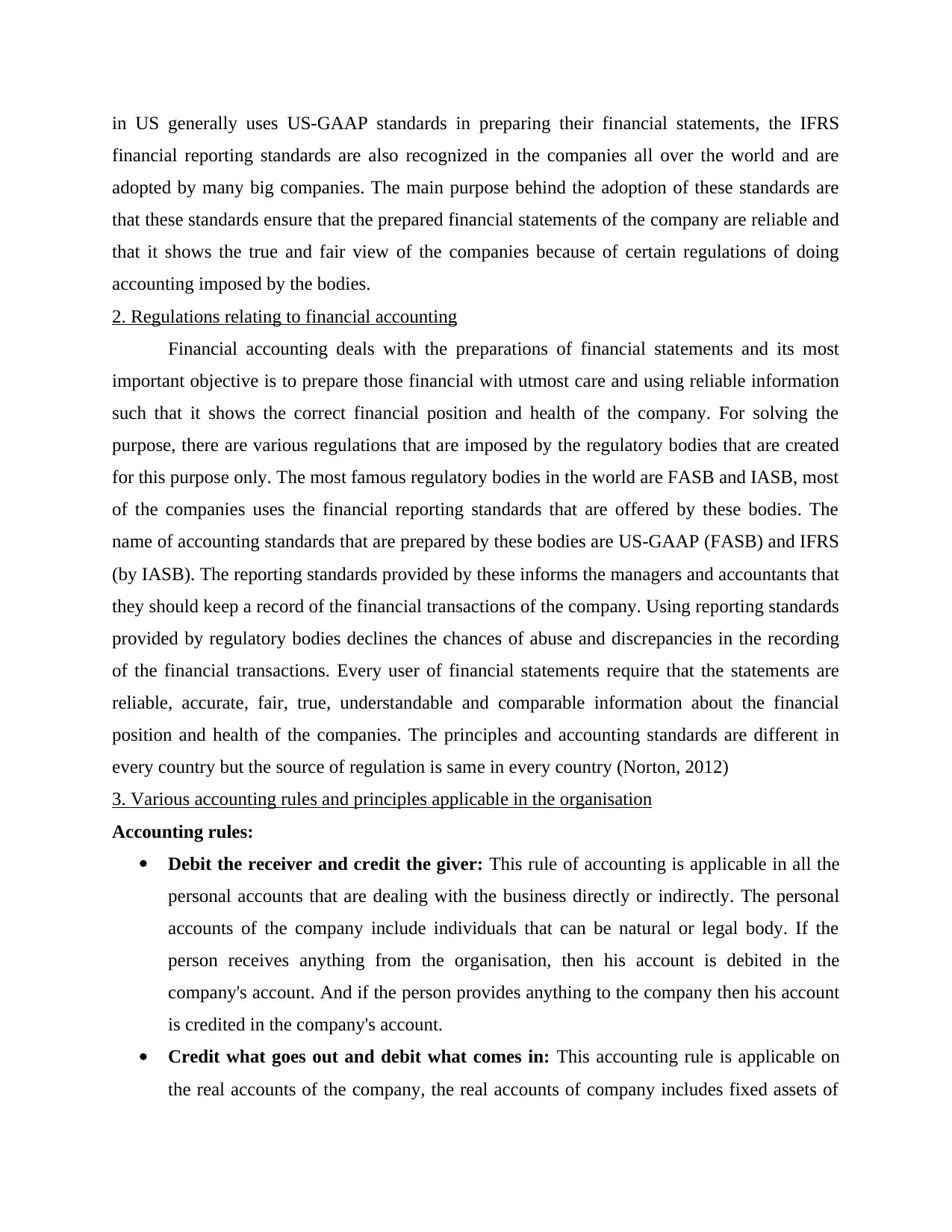
in US generally uses US-GAAP standards in preparing their financial statements, the IFRS
financial reporting standards are also recognized in the companies all over the world and are
adopted by many big companies. The main purpose behind the adoption of these standards are
that these standards ensure that the prepared financial statements of the company are reliable and
that it shows the true and fair view of the companies because of certain regulations of doing
accounting imposed by the bodies.
2. Regulations relating to financial accounting
Financial accounting deals with the preparations of financial statements and its most
important objective is to prepare those financial with utmost care and using reliable information
such that it shows the correct financial position and health of the company. For solving the
purpose, there are various regulations that are imposed by the regulatory bodies that are created
for this purpose only. The most famous regulatory bodies in the world are FASB and IASB, most
of the companies uses the financial reporting standards that are offered by these bodies. The
name of accounting standards that are prepared by these bodies are US-GAAP (FASB) and IFRS
(by IASB). The reporting standards provided by these informs the managers and accountants that
they should keep a record of the financial transactions of the company. Using reporting standards
provided by regulatory bodies declines the chances of abuse and discrepancies in the recording
of the financial transactions. Every user of financial statements require that the statements are
reliable, accurate, fair, true, understandable and comparable information about the financial
position and health of the companies. The principles and accounting standards are different in
every country but the source of regulation is same in every country (Norton, 2012)
3. Various accounting rules and principles applicable in the organisation
Accounting rules:
Debit the receiver and credit the giver: This rule of accounting is applicable in all the
personal accounts that are dealing with the business directly or indirectly. The personal
accounts of the company include individuals that can be natural or legal body. If the
person receives anything from the organisation, then his account is debited in the
company's account. And if the person provides anything to the company then his account
is credited in the company's account.
Credit what goes out and debit what comes in: This accounting rule is applicable on
the real accounts of the company, the real accounts of company includes fixed assets of
financial reporting standards are also recognized in the companies all over the world and are
adopted by many big companies. The main purpose behind the adoption of these standards are
that these standards ensure that the prepared financial statements of the company are reliable and
that it shows the true and fair view of the companies because of certain regulations of doing
accounting imposed by the bodies.
2. Regulations relating to financial accounting
Financial accounting deals with the preparations of financial statements and its most
important objective is to prepare those financial with utmost care and using reliable information
such that it shows the correct financial position and health of the company. For solving the
purpose, there are various regulations that are imposed by the regulatory bodies that are created
for this purpose only. The most famous regulatory bodies in the world are FASB and IASB, most
of the companies uses the financial reporting standards that are offered by these bodies. The
name of accounting standards that are prepared by these bodies are US-GAAP (FASB) and IFRS
(by IASB). The reporting standards provided by these informs the managers and accountants that
they should keep a record of the financial transactions of the company. Using reporting standards
provided by regulatory bodies declines the chances of abuse and discrepancies in the recording
of the financial transactions. Every user of financial statements require that the statements are
reliable, accurate, fair, true, understandable and comparable information about the financial
position and health of the companies. The principles and accounting standards are different in
every country but the source of regulation is same in every country (Norton, 2012)
3. Various accounting rules and principles applicable in the organisation
Accounting rules:
Debit the receiver and credit the giver: This rule of accounting is applicable in all the
personal accounts that are dealing with the business directly or indirectly. The personal
accounts of the company include individuals that can be natural or legal body. If the
person receives anything from the organisation, then his account is debited in the
company's account. And if the person provides anything to the company then his account
is credited in the company's account.
Credit what goes out and debit what comes in: This accounting rule is applicable on
the real accounts of the company, the real accounts of company includes fixed assets of
Paraphrase This Document
Need a fresh take? Get an instant paraphrase of this document with our AI Paraphraser
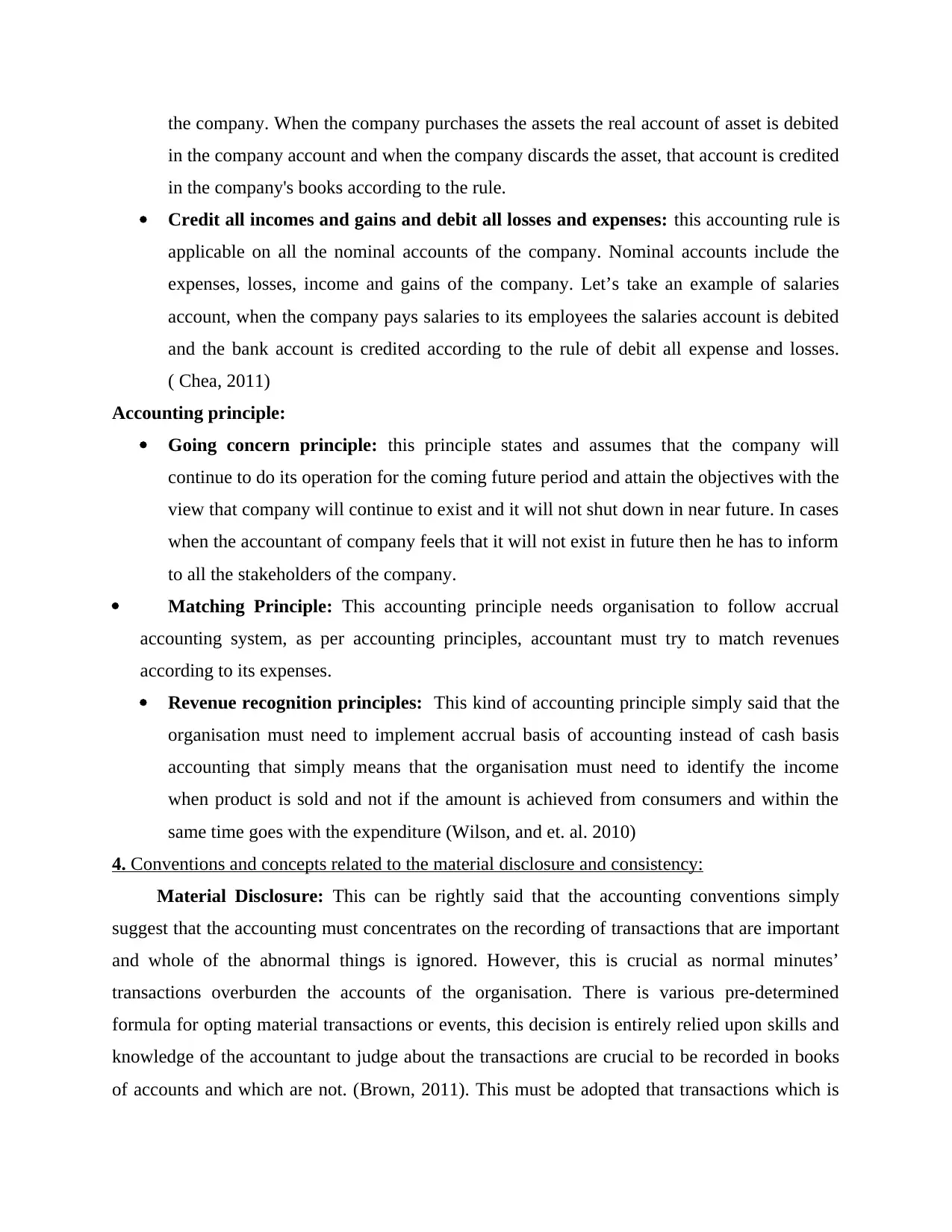
the company. When the company purchases the assets the real account of asset is debited
in the company account and when the company discards the asset, that account is credited
in the company's books according to the rule.
Credit all incomes and gains and debit all losses and expenses: this accounting rule is
applicable on all the nominal accounts of the company. Nominal accounts include the
expenses, losses, income and gains of the company. Let’s take an example of salaries
account, when the company pays salaries to its employees the salaries account is debited
and the bank account is credited according to the rule of debit all expense and losses.
( Chea, 2011)
Accounting principle:
Going concern principle: this principle states and assumes that the company will
continue to do its operation for the coming future period and attain the objectives with the
view that company will continue to exist and it will not shut down in near future. In cases
when the accountant of company feels that it will not exist in future then he has to inform
to all the stakeholders of the company.
Matching Principle: This accounting principle needs organisation to follow accrual
accounting system, as per accounting principles, accountant must try to match revenues
according to its expenses.
Revenue recognition principles: This kind of accounting principle simply said that the
organisation must need to implement accrual basis of accounting instead of cash basis
accounting that simply means that the organisation must need to identify the income
when product is sold and not if the amount is achieved from consumers and within the
same time goes with the expenditure (Wilson, and et. al. 2010)
4. Conventions and concepts related to the material disclosure and consistency:
Material Disclosure: This can be rightly said that the accounting conventions simply
suggest that the accounting must concentrates on the recording of transactions that are important
and whole of the abnormal things is ignored. However, this is crucial as normal minutes’
transactions overburden the accounts of the organisation. There is various pre-determined
formula for opting material transactions or events, this decision is entirely relied upon skills and
knowledge of the accountant to judge about the transactions are crucial to be recorded in books
of accounts and which are not. (Brown, 2011). This must be adopted that transactions which is
in the company account and when the company discards the asset, that account is credited
in the company's books according to the rule.
Credit all incomes and gains and debit all losses and expenses: this accounting rule is
applicable on all the nominal accounts of the company. Nominal accounts include the
expenses, losses, income and gains of the company. Let’s take an example of salaries
account, when the company pays salaries to its employees the salaries account is debited
and the bank account is credited according to the rule of debit all expense and losses.
( Chea, 2011)
Accounting principle:
Going concern principle: this principle states and assumes that the company will
continue to do its operation for the coming future period and attain the objectives with the
view that company will continue to exist and it will not shut down in near future. In cases
when the accountant of company feels that it will not exist in future then he has to inform
to all the stakeholders of the company.
Matching Principle: This accounting principle needs organisation to follow accrual
accounting system, as per accounting principles, accountant must try to match revenues
according to its expenses.
Revenue recognition principles: This kind of accounting principle simply said that the
organisation must need to implement accrual basis of accounting instead of cash basis
accounting that simply means that the organisation must need to identify the income
when product is sold and not if the amount is achieved from consumers and within the
same time goes with the expenditure (Wilson, and et. al. 2010)
4. Conventions and concepts related to the material disclosure and consistency:
Material Disclosure: This can be rightly said that the accounting conventions simply
suggest that the accounting must concentrates on the recording of transactions that are important
and whole of the abnormal things is ignored. However, this is crucial as normal minutes’
transactions overburden the accounts of the organisation. There is various pre-determined
formula for opting material transactions or events, this decision is entirely relied upon skills and
knowledge of the accountant to judge about the transactions are crucial to be recorded in books
of accounts and which are not. (Brown, 2011). This must be adopted that transactions which is
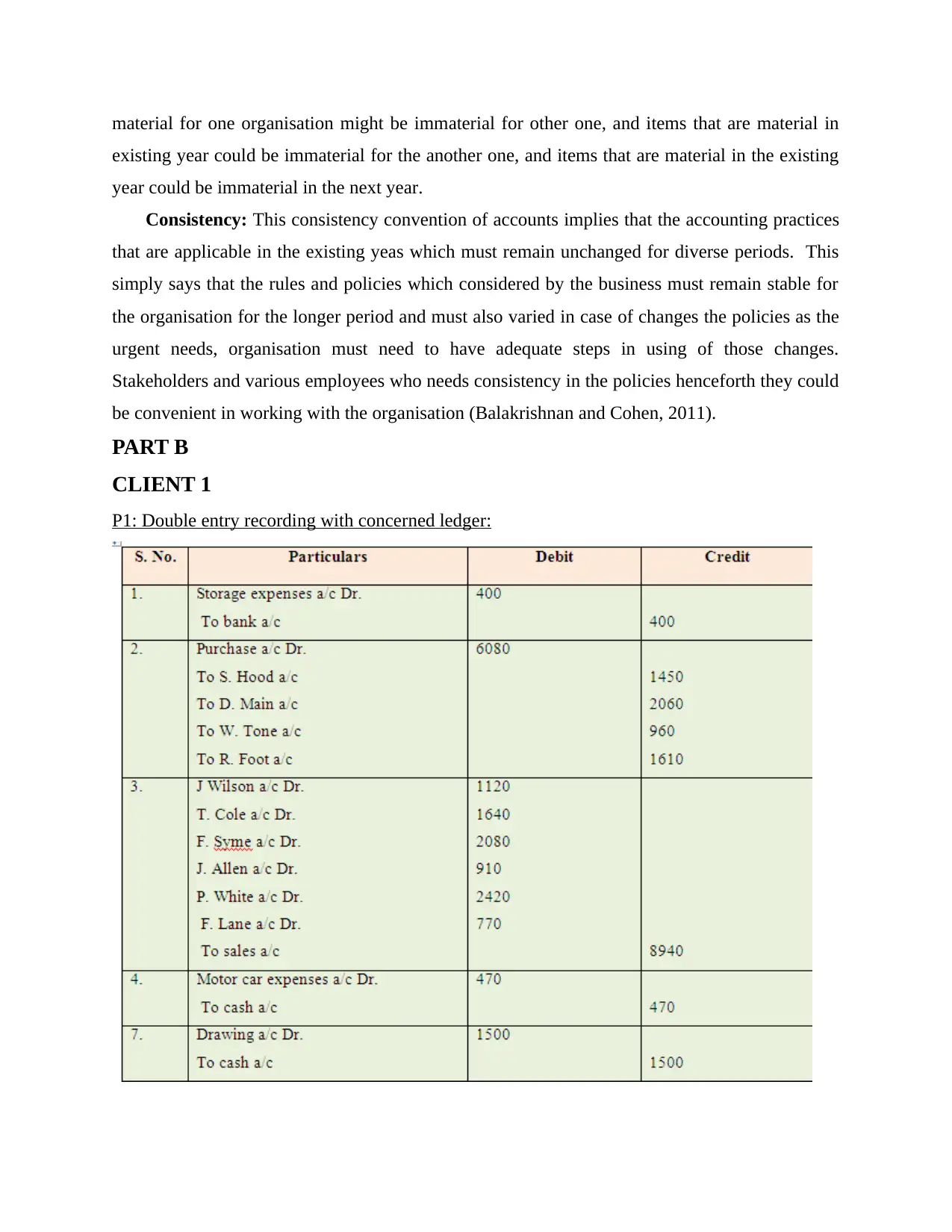
material for one organisation might be immaterial for other one, and items that are material in
existing year could be immaterial for the another one, and items that are material in the existing
year could be immaterial in the next year.
Consistency: This consistency convention of accounts implies that the accounting practices
that are applicable in the existing yeas which must remain unchanged for diverse periods. This
simply says that the rules and policies which considered by the business must remain stable for
the organisation for the longer period and must also varied in case of changes the policies as the
urgent needs, organisation must need to have adequate steps in using of those changes.
Stakeholders and various employees who needs consistency in the policies henceforth they could
be convenient in working with the organisation (Balakrishnan and Cohen, 2011).
PART B
CLIENT 1
P1: Double entry recording with concerned ledger:
existing year could be immaterial for the another one, and items that are material in the existing
year could be immaterial in the next year.
Consistency: This consistency convention of accounts implies that the accounting practices
that are applicable in the existing yeas which must remain unchanged for diverse periods. This
simply says that the rules and policies which considered by the business must remain stable for
the organisation for the longer period and must also varied in case of changes the policies as the
urgent needs, organisation must need to have adequate steps in using of those changes.
Stakeholders and various employees who needs consistency in the policies henceforth they could
be convenient in working with the organisation (Balakrishnan and Cohen, 2011).
PART B
CLIENT 1
P1: Double entry recording with concerned ledger:
⊘ This is a preview!⊘
Do you want full access?
Subscribe today to unlock all pages.

Trusted by 1+ million students worldwide
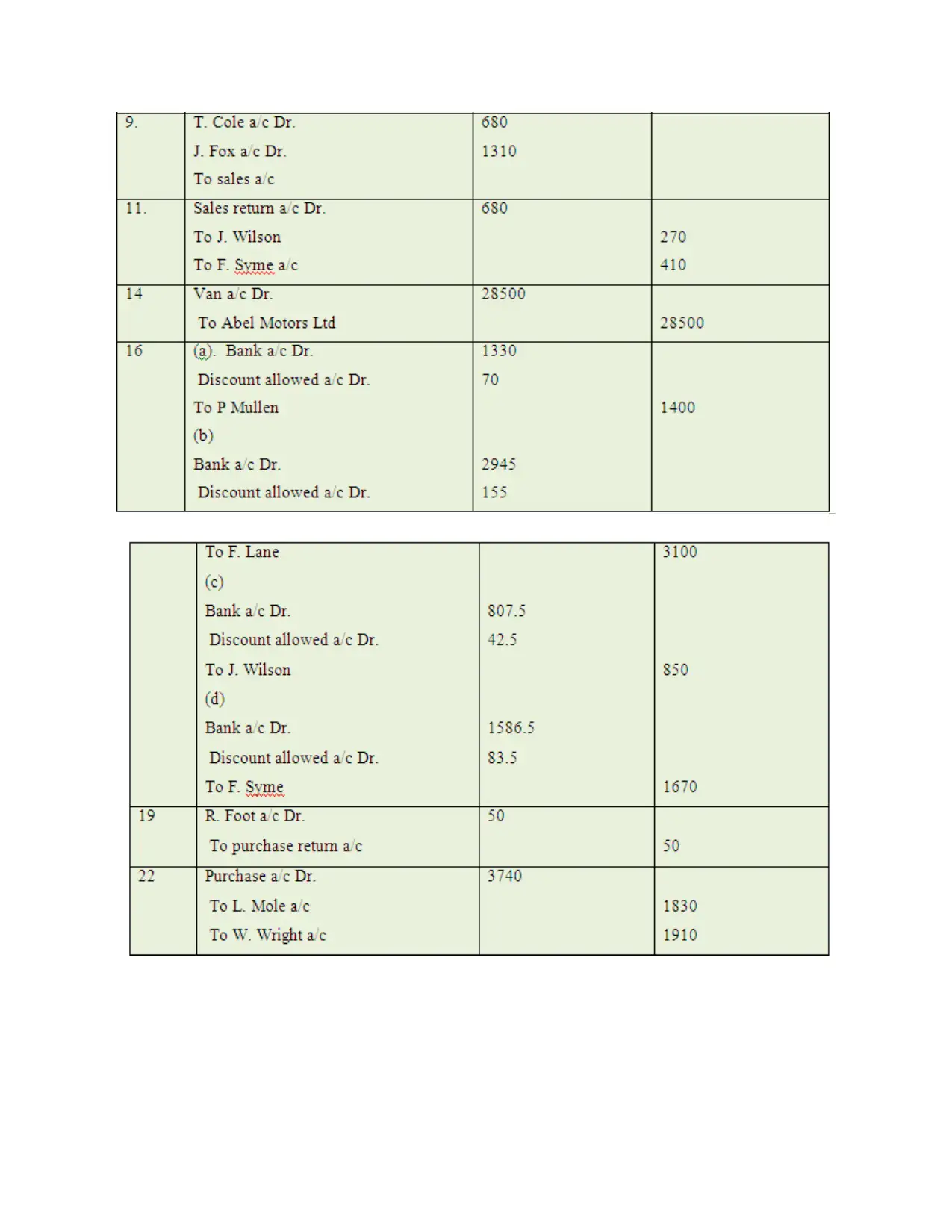
Paraphrase This Document
Need a fresh take? Get an instant paraphrase of this document with our AI Paraphraser
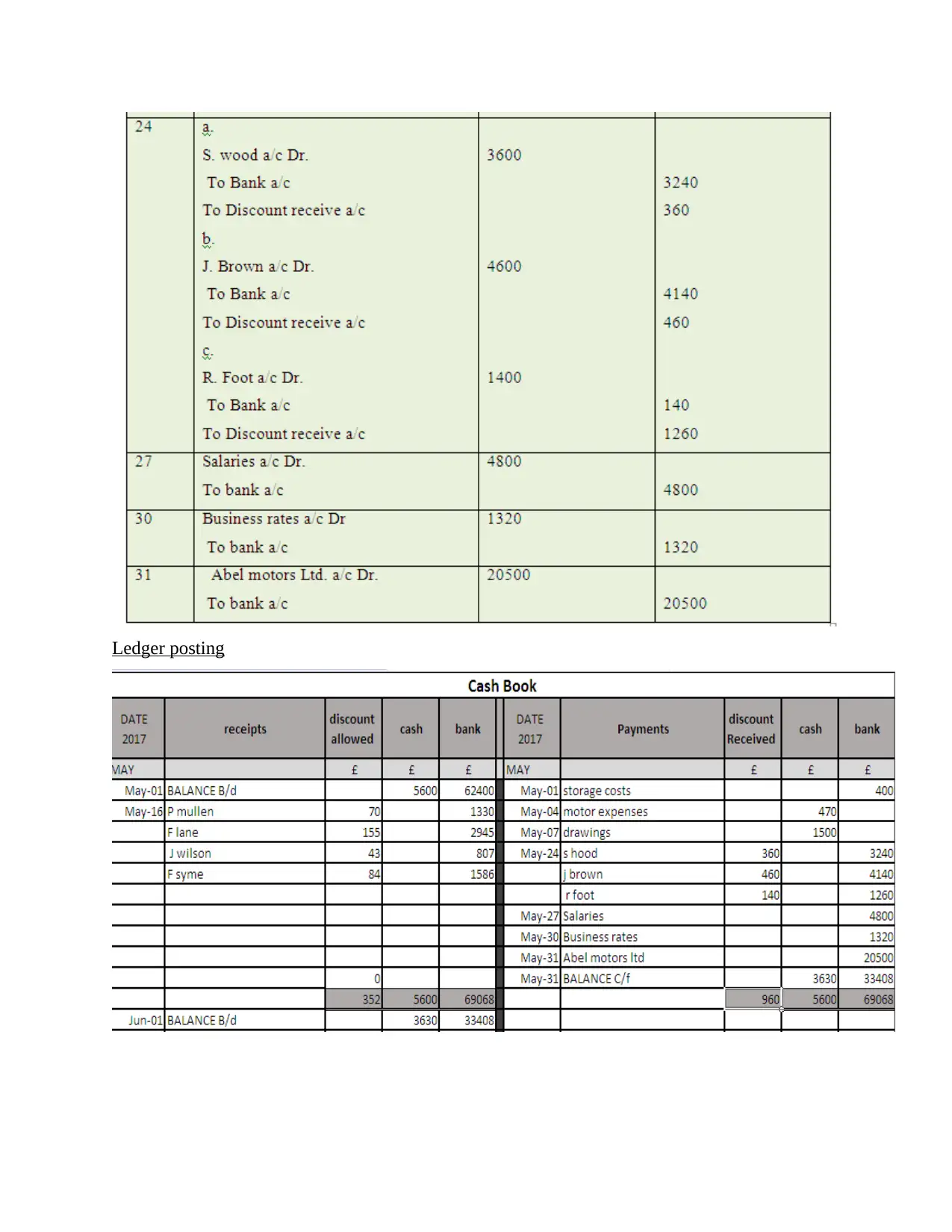
Ledger posting
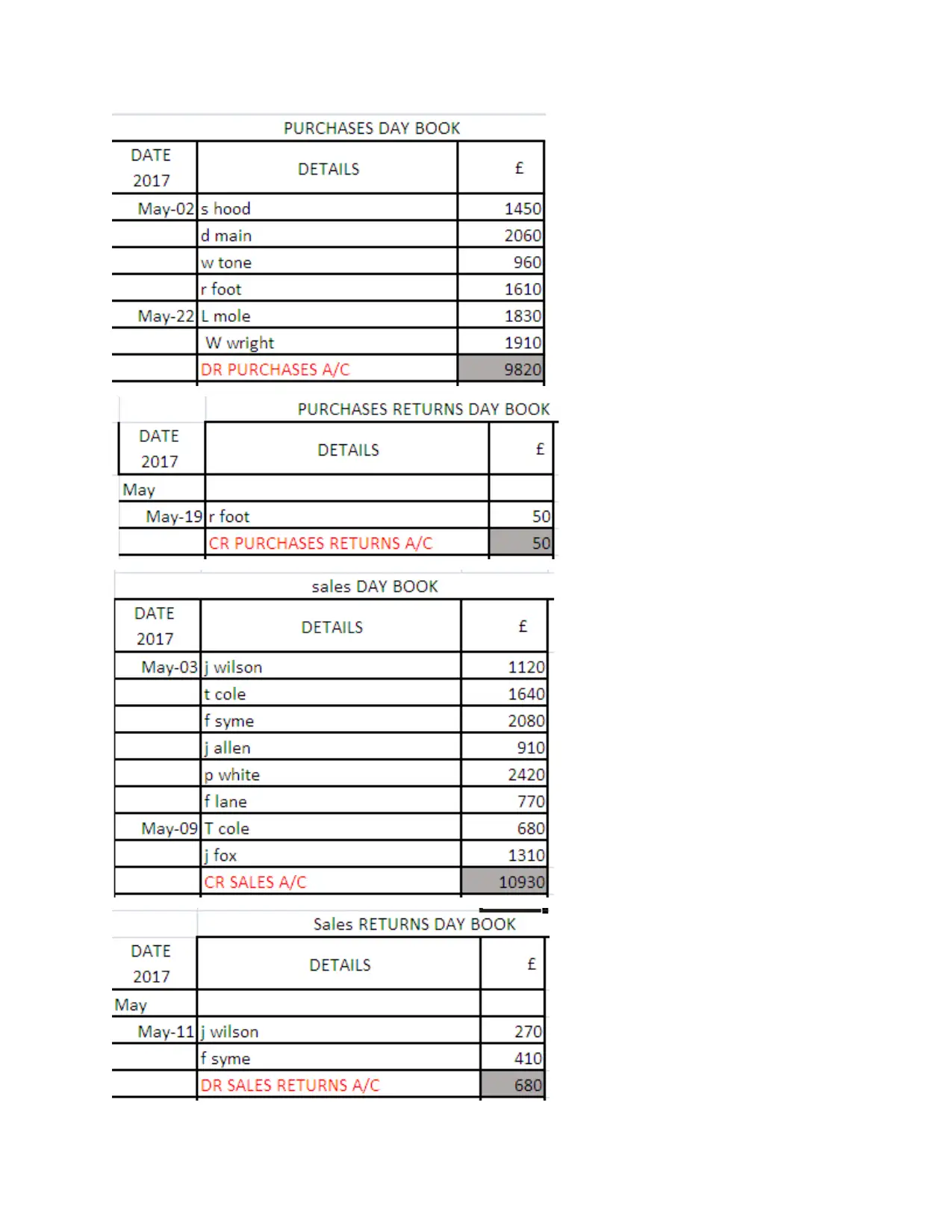
⊘ This is a preview!⊘
Do you want full access?
Subscribe today to unlock all pages.

Trusted by 1+ million students worldwide
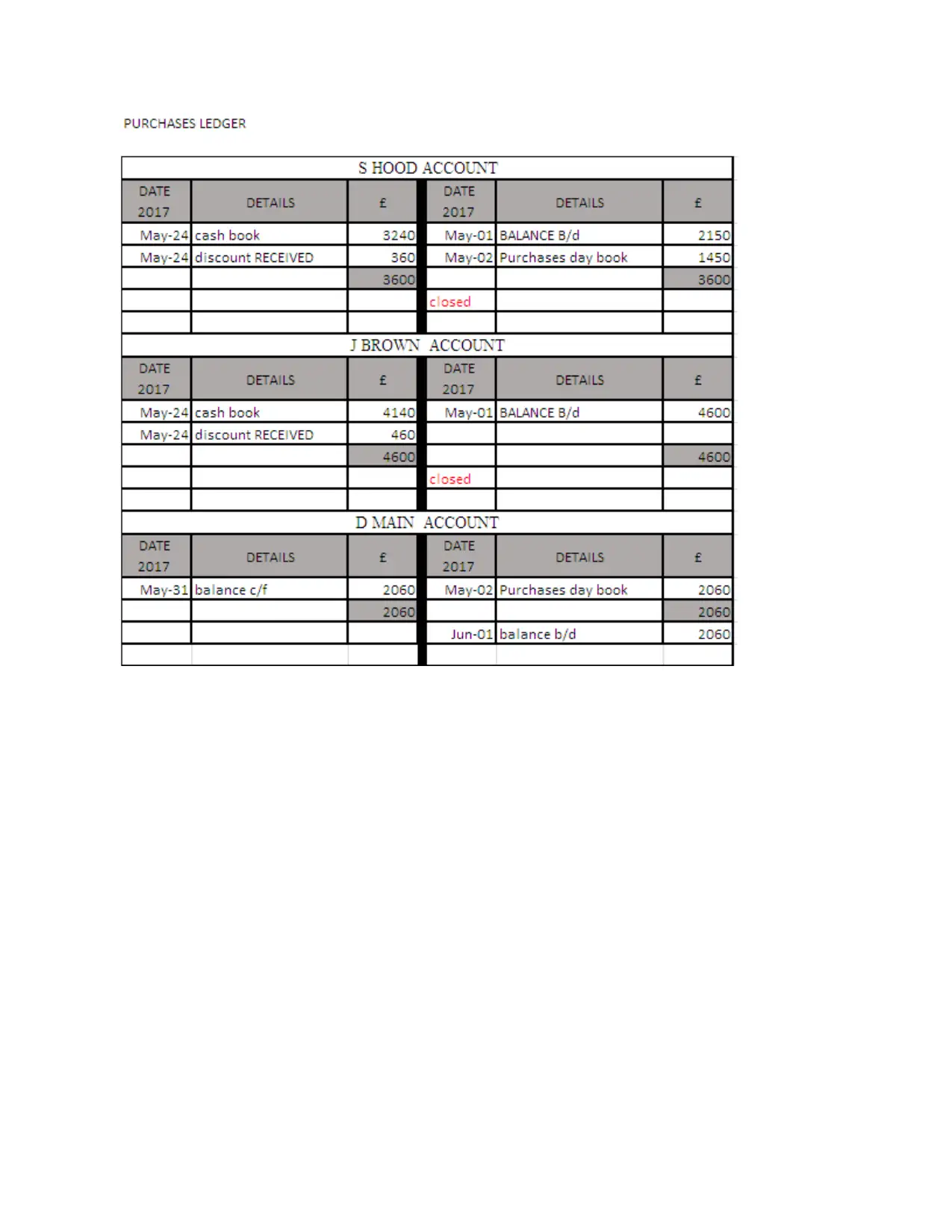
Paraphrase This Document
Need a fresh take? Get an instant paraphrase of this document with our AI Paraphraser

Sales ledger account:
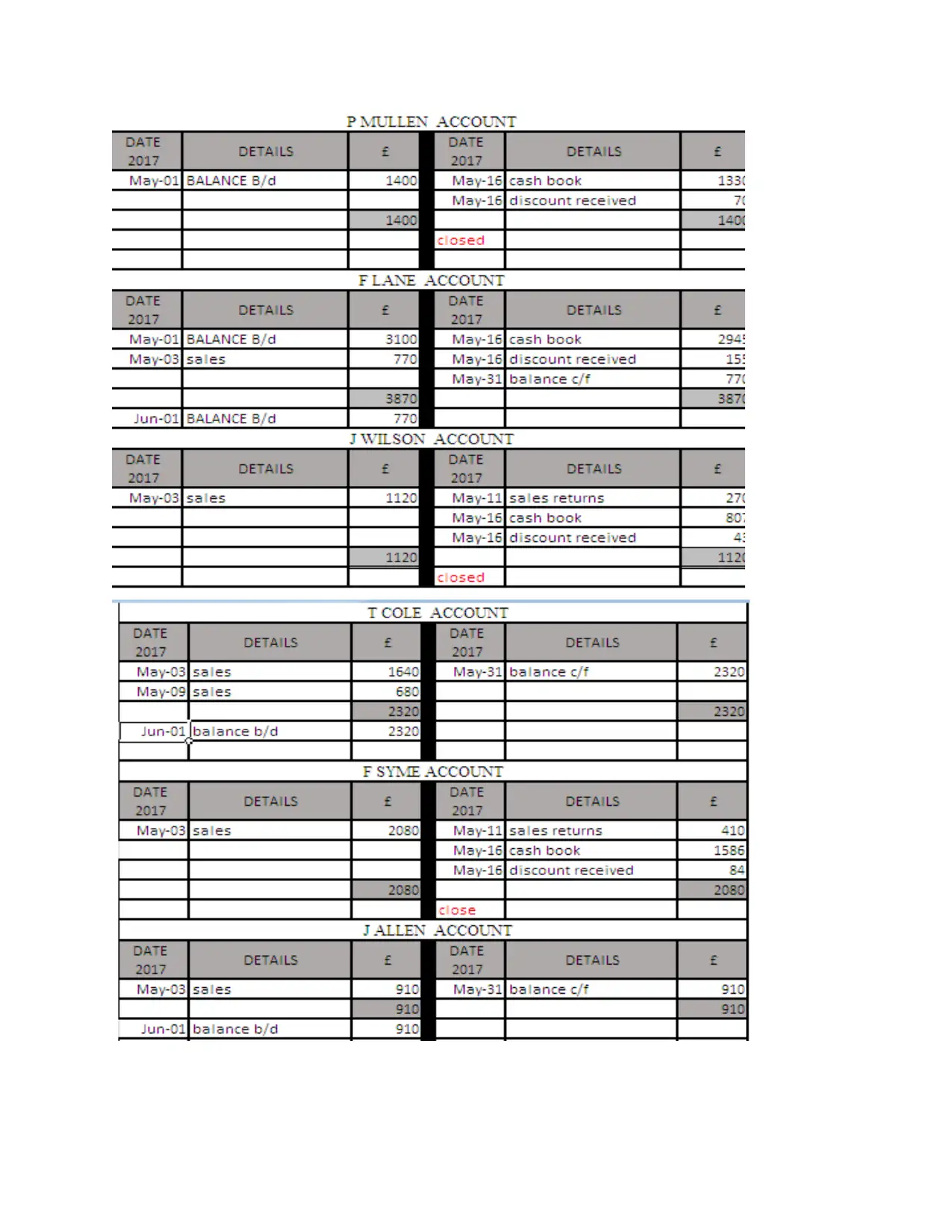
⊘ This is a preview!⊘
Do you want full access?
Subscribe today to unlock all pages.

Trusted by 1+ million students worldwide
1 out of 26
Related Documents
Your All-in-One AI-Powered Toolkit for Academic Success.
+13062052269
info@desklib.com
Available 24*7 on WhatsApp / Email
![[object Object]](/_next/static/media/star-bottom.7253800d.svg)
Unlock your academic potential
Copyright © 2020–2026 A2Z Services. All Rights Reserved. Developed and managed by ZUCOL.





